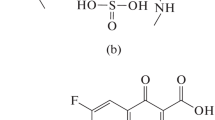Summary
Resorbable poly-l-lactic acid (PLLA) cylinders (3.5 mm diameter, 5 mm in length) carrying 6% of weight ciprofloxacin (Ciprobay, Bayer AG, Leverkusen, FRG) were investigated in vitro to explore their properties as a slow-release antibiotic deposit. Forty bioactive cylinders stored in test tubes were covered with phosphate buffer (pH 7.4 at 37°C) and 40 with fresh human blood plasma and tested under various conditions. For comparison a gentamicin-polymethylmethacrylate (PMMA) chain (Septopal, E. Merck, Darmstadt, FRG) was exposed to similar test conditions. The quantities of ciprofloxacin and gentamicin released were analysed by a microbiological method (bioassay). The concentrations of ciprofloxacin released were analysed by a microbiological method (bioassay). The concentrations of ciprofloxacin released from 40 cyclinder were initially very high (up to 180 mg/1) but they decreased rapidly within the first 5 days (4.2–22.5 mg/l). Early release of gentamicin reached up to 227.5 mg/l but dropped to of 22 mg/l on the 14th day. Complete degradation of the PLLA-cylinders was not seen in the observed period of 92 days. The mean loss of mass was 8.4%, The recovery of incorporated ciprofloxacin was 6.5% on average.
Similar content being viewed by others
References
Bauernfeind A (1985) Antimicrobial activity of ciprofloxacin: an overview. Proceedings of the 1st International Ciprofloxacin Workshop, Leverkusen, pp 7–11
Bos RR, Boering G, Rozema FR, Leenslag JW (1987) Resorbable poly-(l)-lactide plates and screws for the fixation of zygomatic fractures. J Maxillofacial Surg 45:751–753
Braun R, Duerig M, Hader F (1985) Penetration of ciprofloxacin into bone tissue. 14th International Congress of Chemotherapy, Kyoto, Japan, Abstracts, p 37–85
Cutright DE, Perez B, Beasley JD, Larson WJ, Posey WR (1974) Degradation rates of polymers/copolymers of polylactic and polyglycolic acids. Oral Surg 37:142–152
Gentschew G, Stille W (1987) Lokaltherapie mit Gyrasehemmern. In-vitro-Untersuchung zur Freisetzung von Gyrasehemmern aus Knochenzement. FAC 6-10. Fortschr Antimikrob Antinepol Chemother 207–215
Getter L, Cutright DE, Bhaskar SN, Augsburg JK (1972) A biodegradable intraosseous appliance in the treatment of mandibular fractures. J Oral Surg 30:344–348
Hollinger JO (1983) Preliminary report on the osteogenetic potential of biodegradable copolymer of polyactide (PLA) and polyglycolide (PGA). J Biomed Mater Res 17:71–82
Reed AM, Gilding DK (1981) Biodegradable polymers for use in surgery — poly (glycolic)/poly (lactic acid) homo- and copolymers. 2. In-vitro degradation. Polymer 22:494–498
Wahlig H, Hameister W, Grieben A (1972) Über die Freisetzung von Gentamycin aus Polymethylmethacrylat. I. Experimentelle Untersuchungen in vitro. Langenbecks Arch Chir 331:169–192
Author information
Authors and Affiliations
Rights and permissions
About this article
Cite this article
Teupe, C., Meffert, R., Winckler, S. et al. Ciprofloxacin-impregnated poly-l-lactic acid drug carrier. Arch Orthop Trauma Surg 112, 33–35 (1992). https://doi.org/10.1007/BF00431041
Received:
Issue Date:
DOI: https://doi.org/10.1007/BF00431041




